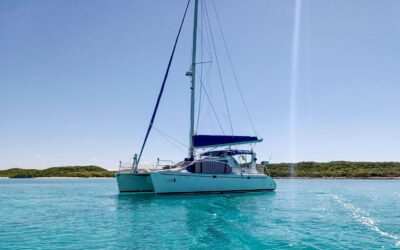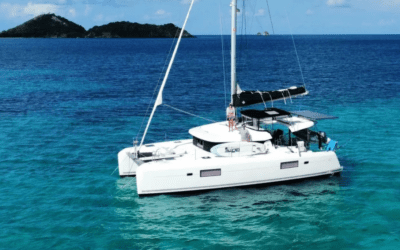
THE SELL
Let our years of experience help you navigate your last passage through the potentially treacherous waters of a boat deal.
Receiving an Offer
A formal offer is written on a Purchase Agreement. The basic components to the offer are:
• Offer Amount: what price is being offered to purchase your vessel
• Offer expiration date: when the offer will expire.
• Terms of Sale: what the sale is subject to.
• 10% Deposit: the “good faith” deposit of honest interest to purchase your vessel.
• Acceptance Date: the date by which the buyer will decide to move forward with the deal after conducting a sea trial and survey.
• Closing Date: when your vessel is sold.
The ‘subject to’ items will contain some or all or the following:
• Personal Inspection This grants the buyer the right to cancel the agreement if he/she doesn’t like what they see. This usually takes place before the survey and sea trail.
• Marine Survey The buyer will hire a 3rd party professional marine surveyor to inspect the vessel and ensure its seaworthiness. A surveyor will provide the buyer with a complete report of the vessel’s deficiencies within 1-2 days of inspection.
• Sea Trial Usually done the day of the survey inspection.
The buyer may also want to include additional terms, such as “Subject to Financing”.
An average sale from Offer to Closing can take place in as little as a month, with a typical timeframe as follows:
Offer Date: Today
Offer Expires: 2-3 days
Acceptance of Vessel: 2 weeks from today
Closing date: 1 month from today
It is important to note that a buyer’s deposit is fully refundable up until the Acceptance of Vessel date. After the vessel has been accepted, the buyer has to complete the deal or risk forfeiting his deposit. It is also important to note that California and Florida are the only states that regulate escrow accounts and require yacht brokers to have a license.
Also included with the offer is an “Exhibit A”, which is usually comprised of the listing advertisement information, so that both parties are in agreement as to what is actually being sold.
Once a buyer has filled in the agreement, signed each page, including the Exhibit A and the buyer’s broker is in receipt of the buyer’s 10% deposit, we will receive an offer to purchase your vessel.
2. Offer Negotiations
After we receive the offer from the buyer, we can either (1) accept the offer as it is; (2) send back a “counter offer” with changes to the offer; or (3) reject the offer outright. Usually we will come back with a counter offer and this negotiation continues until the offer terms are agreeable to both parties. Once agreed, we are “Under Contract”.
3. Under Contract
At this stage, you have agreed to the offer and we will need to prepare for the sea trial and survey prior to the Acceptance of Vessel date. We will help you coordinate boat yard hauls, captain schedules, cleaning, preparation of the vessel, etc. so that your vessel is ready for its sea trail and survey.
Because a Marine Survey and Sea Trial are common, here is what you can expect:
• The seller is responsible for moving (or hiring a Captain to move) the vessel to the yard location for survey and captain the sea trial. (It is, after all, still your boat.)
• The buyer is responsible for payment to his surveyor and payment to the yard for haul. (They are, after all, his terms).
The survey and sea trial are typically held the same day, limiting the costs involved for everyone. The surveyor, your captain, and your broker will be present at the boat early in the morning (8/8:30-am) in order to hear the engine at first crank, a “cold engine start”. You do not have to attend your survey, but if you are not captaining your vessel, you will need to arrange a captain to do that for you. Many times it is quite beneficial to captain your vessel yourself as you are familiar with all its systems and idiosyncrasies. You may be able to avoid unnecessary worries when you are able to answer a surveyors questions on the spot. The surveyor will proceed to check the vessel’s systems and equipment while the boat is in the water.
A survey haul is usually scheduled for mid-day with a hang in the slings for about an hour; this gives the surveyor plenty of time to let her dry, pound the hulls and inspect the bottom of the vessel.
After the surveyor inspects the bottom of the hull, the vessel is put back into the water and we take her out for a sea trial. If your catamaran is a sailboat, the sails are raised so they too can be inspected.
By 4pm, we are usually back on the dock. The surveyor usually takes this time to discuss any issues with the buyer even though the survey report will only be issued within 24-48hrs. Sometimes, a conditional acceptance is agreed upon on the spot while both the buyer and yourself, as well as the brokers, are available for further negotiations on items that may have come up during the sea trail and survey.
Acceptance of Vessel
If the Sea Trail and Survey Report were positive and successful, the buyer may decide to sign the Acceptance of Vessel (AOV) any time on or before your Acceptance of Vessel date.
Once the buyer receives the surveyor report, he may request adjustments in price based on the report. This can be negotiated in either repairs or compensation for repairs needed. This is known as a Conditional Acceptance of Vessel (CAOV).
It has to be noted that the purchase of a used vessel, a buyer cannot expect to focus on items that are viewed as normal ‘wear and tear’ for a used vessel. Therefore, it is usually a rule of thumb that only large ticket items are negotiated in post-survey adjustments. These will include the large working items of a vessel, namely the sails, engines, navigational equipment and not a faulty light in the bathroom, or the scratch in the door etc. If, however, items such as a faulty generator was made known before the offer to purchase the vessel, these items cannot be used as fodder in a post-survey adjustment. Only new faulty items can be brought into this negotiation.
One more thing, due to the fact that it is a used vessel, a buyer can usually request around 50% of the cost to replace or repair the damaged items. Many buyers think that they will negotiate the price down after survey, but this is not the case.
If the buyer no longer wants the vessel, he will need to submit his rejection in writing (email, fax, etc.) A buyer does not even have to give a reason for the rejection. If there is no written acceptance of vessel on or before the Acceptance of Vessel date, it will be deemed as an automatic rejection of the vessel.
If a buyer cannot send a written acceptance on time, the buyer may request for an extension, or reject the vessel and submit a new offer when possible. Usually an extension is acceptable if there is a valid reason.
Should there be repairs contingent on an acceptance, be sure to confirm with the surveyor once they have been completed successfully. This needs to be signed off on before the Acceptance is in effect.
Upon Acceptance of Vessel, you are now in the final stage and getting ready to close.
5. The Closing
The Closing Date, which is usually set for two weeks after the Acceptance of Vessel date, allows for the time it requires to bring together all the items necessary to transfer ownership. The Closing Date is an outside date and oftentimes happens sooner.
Basically, a closing takes place once both of the following items are in place: firstly, the FULL and CLEARED closing funds have been received into the buyer broker’s Escrow Account (most lending companies will only wire the financed funds on the day of closing); and secondly, the Documentation agent is in possession of all the necessary ORIGINAL documents from the seller.
There are a few things to be aware of during the closing process:
1. A buyer’s Documentor will be in touch with you to have you sign and notarize any and all necessary paperwork to transfer ownership of the vessel to the buyer. Our closing department, will be working in conjunction with the Documentation Agent to ensure all things run along smoothly. The Documentor will request all the documents that were collected from you at the time of listing. It is important to make sure that you return all and necessary original and notarized documents to the Documentor in a timeous manner to facilitate as closing cannot take place until the Documentor is in possession of these items.
2. Provide information of your Financing representative, if necessary. The details of any lien amount needs to be included in the closing statement for the vessel and special arrangements are made to make sure all necessary lien funds are correct for closing – pro-diem rates usually apply. Again, our closing department will liaise with the Financing Company to confirm all necessary documents are received and sent between the buyer and Documentation agent etc.
3. Full and cleared closing funds are to be received by the buyer’s broker before closing can take place. It is the responsibility of the buyer to make sure that closing funds are paid in a timeous manner. A closing statement will confirm the final closing funds required. We will receive confirmation from the buyer’s broker when full and cleared funds have been received.
4. The 10% Commission, lien amounts and any outstanding dockage or maintenance fees will be included in the closing statement to reflect what amount will be wired to you at closing. Your wire transfer instructions will be requested.
5. Only cancel your insurance once closing has taken place. Sometimes, there may be an extension of closing required.
6. Sometimes an arrangement can be made for the buyer to take over the dockage where your vessel is currently located. This should be arranged prior to closing.
7. On the day of closing your funds and your lien funds will be wired out.
Remember, your broker is always still available for you through this process although they may not be actively involved in all the paperwork side of things.
Congratulations! You have sold your catamaran. Thank you for giving us the opportunity to help you. Remember, if you ever need another catamaran, we are here to help you find it.



